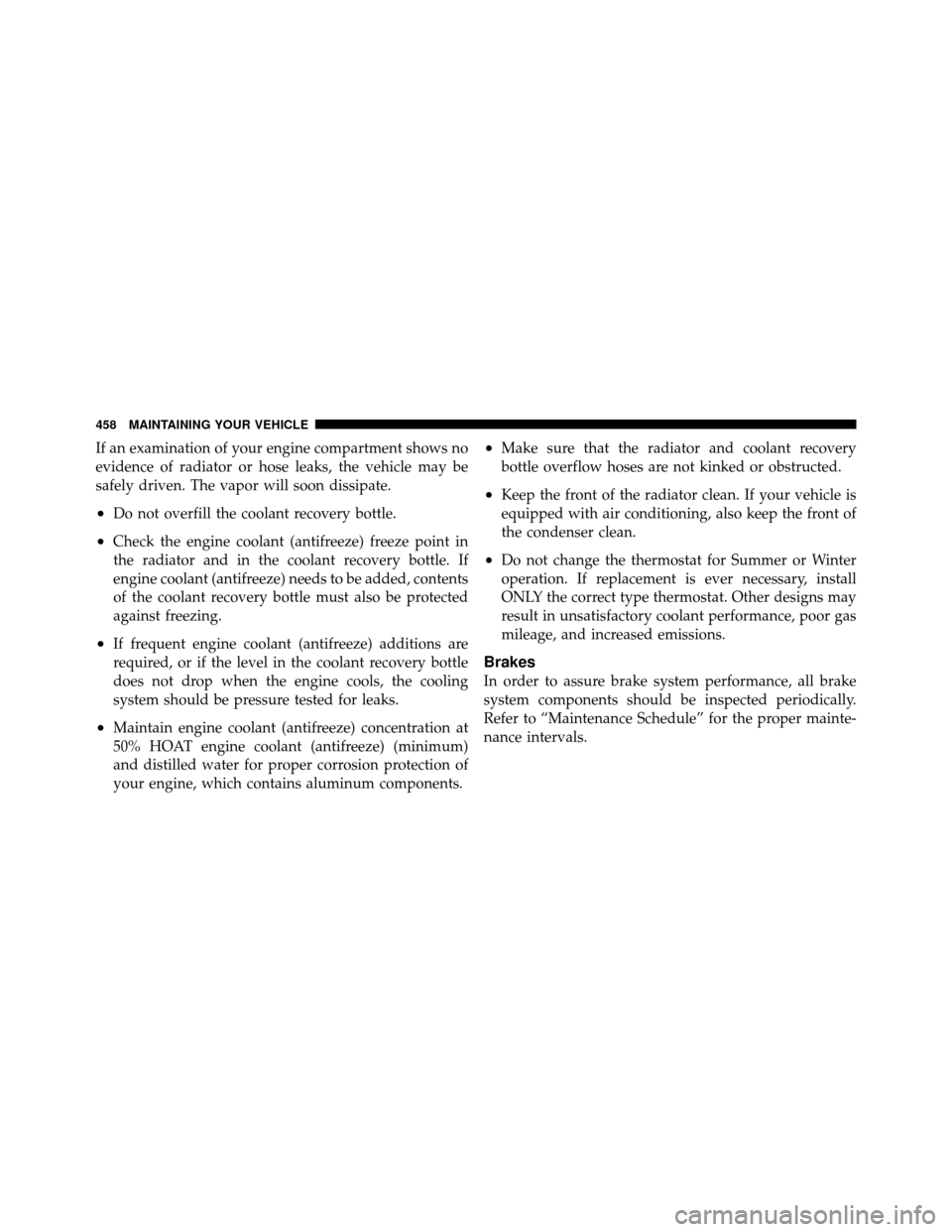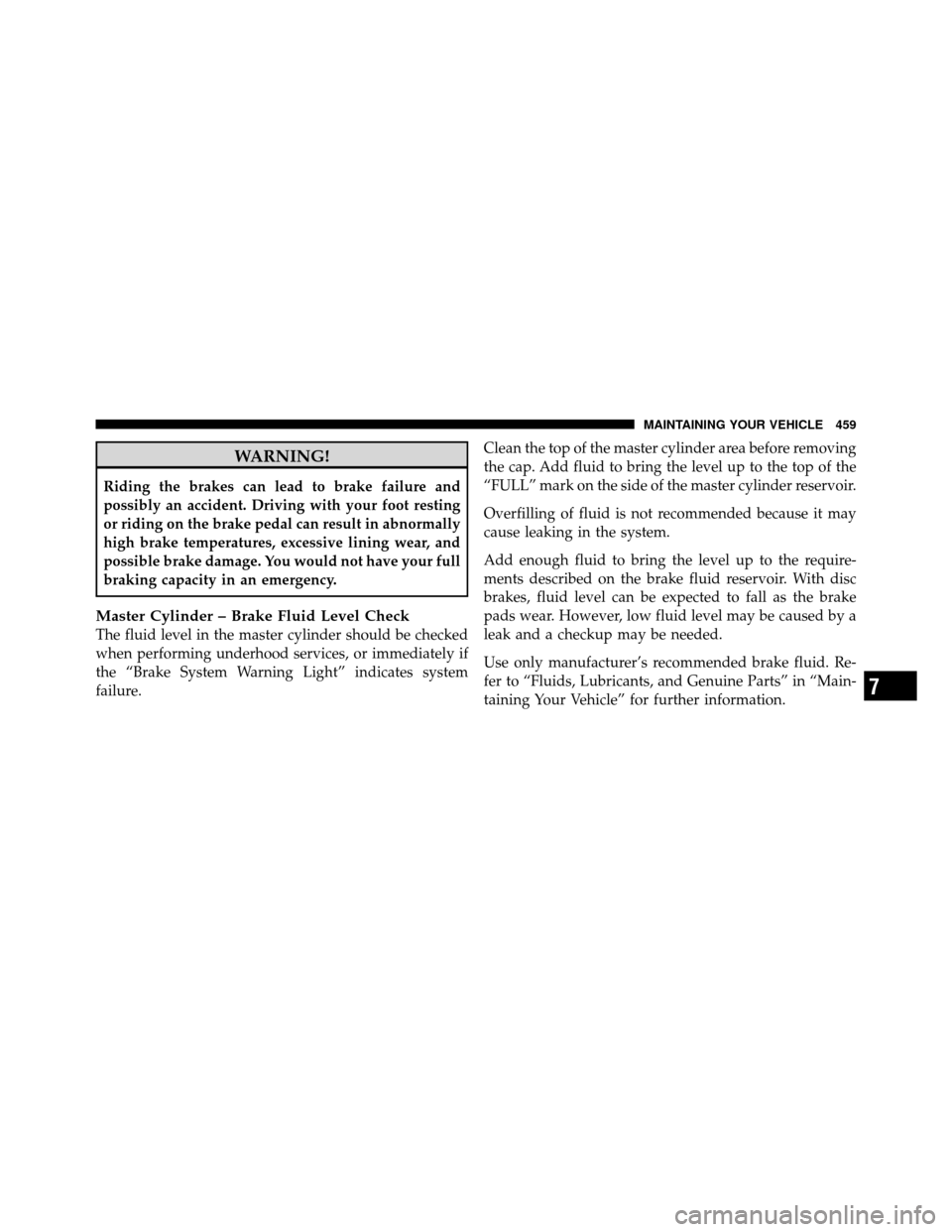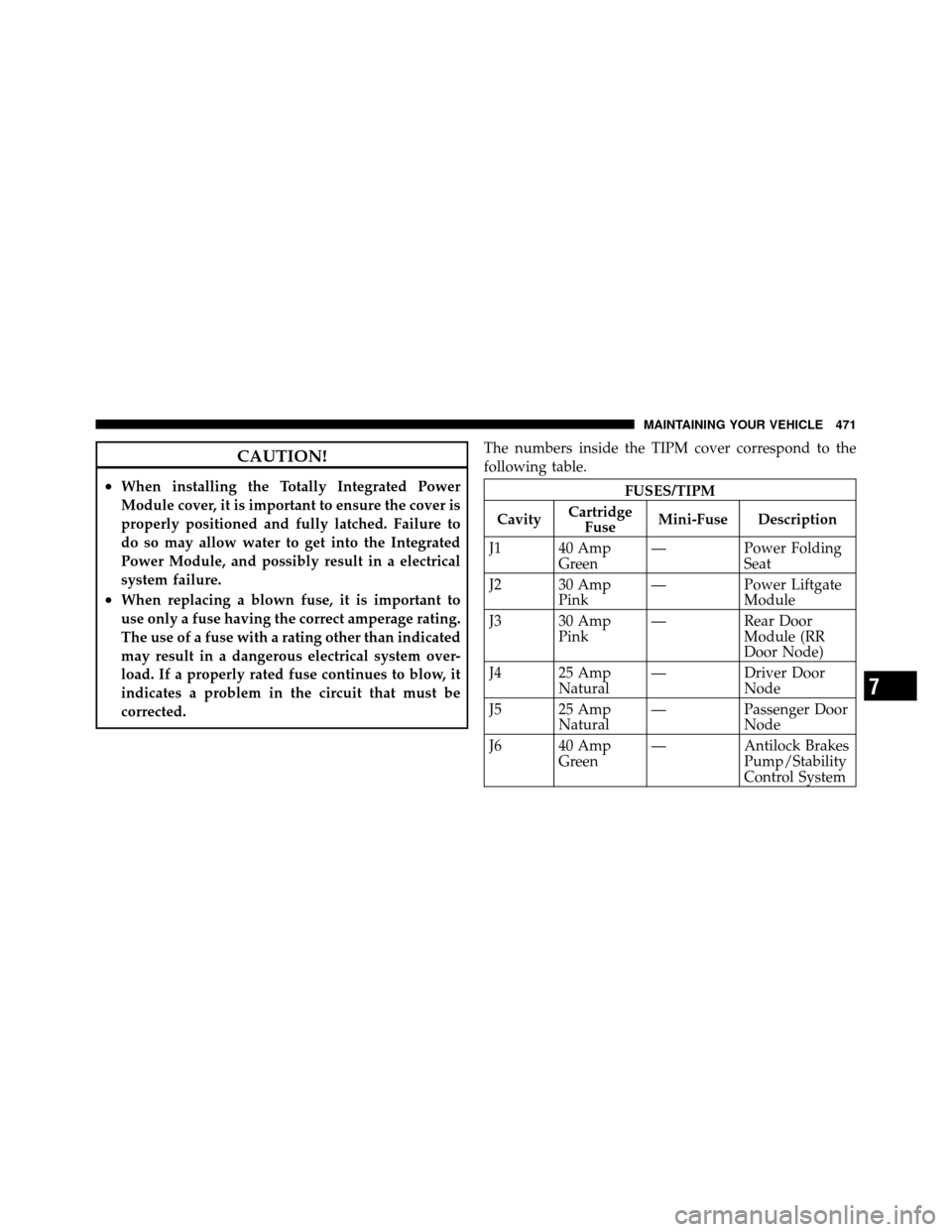Page 405 of 538

WARNING! (Continued)
3. GAWR
4. Trailer tongue weight rating for that trailer hitch.
(This requirement may limit the ability to always
achieve the 10% to 15% range of trailer tongue weight
as a percentage of total trailer weight.)
Towing Requirements – Tires
•
Do not attempt to tow a trailer while using a compact
spare tire.
•Proper tire inflation pressures are essential to the safe
and satisfactory operation of your vehicle. Refer to
“Tires – General Information” in “Starting and Oper-
ating” for proper tire inflation procedures.
•Check the trailer tires for proper tire inflation pres-
sures before trailer usage.
•Check for signs of tire wear or visible tire damage
before towing a trailer. Refer to “Tires – General
Information” in “Starting and Operating” for the
proper inspection procedure.
•When replacing tires, refer to “Tires – General Infor-
mation” in “Starting and Operating” for proper tire
replacement procedures. Replacing tires with a higher
load carrying capacity will not increase the vehicle’s
GVWR and GAWR limits.
Towing Requirements – Trailer Brakes
•
Donot interconnect the hydraulic brake system or
vacuum system of your vehicle with that of the trailer.
This could cause inadequate braking and possible
personal injury.
404 STARTING AND OPERATING
Page 406 of 538

•An electronically actuated trailer brake controller is
required when towing a trailer with electronically
actuated brakes. When towing a trailer equipped with
a hydraulic surge actuated brake system, an electronic
brake controller is not required.
•Trailer brakes are recommended for trailers over
1,000 lbs (454 kg) and required for trailers in excess of
2,000 lbs (907 kg).
CAUTION!
If the trailer weighs more than 1,000 lbs (454 kg)
loaded, it should have its own brakes and they
should be of adequate capacity. Failure to do this
could lead to accelerated brake lining wear, higher
brake pedal effort, and longer stopping distances.
WARNING!
•Do not connect trailer brakes to your vehicle’s
hydraulic brake lines. It can overload your brake
system and cause it to fail. You might not have
brakes when you need them and could have an
accident.
•Towing any trailer will increase your stopping
distance. When towing you should allow for addi-
tional space between your vehicle and the vehicle
in front of you. Failure to do so could result in an
accident.
Towing Requirements – Trailer Lights and Wiring
Whenever you pull a trailer, regardless of the trailer size,
stop lights and turn signals on the trailer are required for
motoring safety.
5
STARTING AND OPERATING 405
Page 408 of 538
Towing Tips
Before setting out on a trip, practice turning, stopping
and backing the trailer in an area away from heavy
traffic.
Automatic Transmission
The DRIVE gear can be selected when towing. However,
if frequent shifting occurs while in DRIVE, move the shift
lever into third gear (with four-speed transmission) or
fifth gear (with six-speed transmission).
NOTE:Moving the shift lever into third gear (with
four-speed transmission) or fifth gear (with six-speed
transmission) while operating the vehicle under heavy
operating conditions will improve performance and ex-
tend transmission life by reducing excessive shifting and
heat build up. This action will also provide better engine
braking.
Seven-Pin Connector
1 — Battery 5 — Ground
2 — Backup Lamps 6 — Left Stop/Turn
3 — Right Stop/Turn 7 — Running Lamps
4 — Electric Brakes
5
STARTING AND OPERATING 407
Page 435 of 538

▫Brakes ............................ 458
▫ Automatic Transmission ............... 461
▫ Appearance Care And Protection From
Corrosion .......................... 464
▫ Cleaning The Instrument Panel Cupholders . . 469
� Fuses .............................. 470
▫ Totally Integrated Power Module (TIPM) . . . 470
� Vehicle Storage ....................... 479
� Replacement Bulbs .................... 479
� Bulb Replacement ..................... 480
▫ High Intensity Discharge Headlamps (HID)
— If Equipped ...................... 480
▫ Quad Headlamps .................... 481 ▫
Front Park/Turn Signal Lamp ........... 481
▫ Front Side Marker Lamp ............... 482
▫ Fog Lamp ......................... 482
▫ Rear Tail, Stop, Turn Signal, Side Marker
And Backup Lamp ................... 482
▫ Center High-Mounted Stop Lamp
(CHMSL) .......................... 484
▫ License Lamp ....................... 484
� Fluid Capacities ...................... 485
� Fluids, Lubricants And Genuine Parts ....... 486
▫ Engine ............................ 486
▫ Chassis ........................... 487
434 MAINTAINING YOUR VEHICLE
Page 459 of 538

If an examination of your engine compartment shows no
evidence of radiator or hose leaks, the vehicle may be
safely driven. The vapor will soon dissipate.
•Do not overfill the coolant recovery bottle.
•Check the engine coolant (antifreeze) freeze point in
the radiator and in the coolant recovery bottle. If
engine coolant (antifreeze) needs to be added, contents
of the coolant recovery bottle must also be protected
against freezing.
•If frequent engine coolant (antifreeze) additions are
required, or if the level in the coolant recovery bottle
does not drop when the engine cools, the cooling
system should be pressure tested for leaks.
•Maintain engine coolant (antifreeze) concentration at
50% HOAT engine coolant (antifreeze) (minimum)
and distilled water for proper corrosion protection of
your engine, which contains aluminum components.
•Make sure that the radiator and coolant recovery
bottle overflow hoses are not kinked or obstructed.
•Keep the front of the radiator clean. If your vehicle is
equipped with air conditioning, also keep the front of
the condenser clean.
•Do not change the thermostat for Summer or Winter
operation. If replacement is ever necessary, install
ONLY the correct type thermostat. Other designs may
result in unsatisfactory coolant performance, poor gas
mileage, and increased emissions.
Brakes
In order to assure brake system performance, all brake
system components should be inspected periodically.
Refer to “Maintenance Schedule” for the proper mainte-
nance intervals.
458 MAINTAINING YOUR VEHICLE
Page 460 of 538

WARNING!
Riding the brakes can lead to brake failure and
possibly an accident. Driving with your foot resting
or riding on the brake pedal can result in abnormally
high brake temperatures, excessive lining wear, and
possible brake damage. You would not have your full
braking capacity in an emergency.
Master Cylinder – Brake Fluid Level Check
The fluid level in the master cylinder should be checked
when performing underhood services, or immediately if
the “Brake System Warning Light” indicates system
failure.Clean the top of the master cylinder area before removing
the cap. Add fluid to bring the level up to the top of the
“FULL” mark on the side of the master cylinder reservoir.
Overfilling of fluid is not recommended because it may
cause leaking in the system.
Add enough fluid to bring the level up to the require-
ments described on the brake fluid reservoir. With disc
brakes, fluid level can be expected to fall as the brake
pads wear. However, low fluid level may be caused by a
leak and a checkup may be needed.
Use only manufacturer’s recommended brake fluid. Re-
fer to “Fluids, Lubricants, and Genuine Parts” in “Main-
taining Your Vehicle” for further information.
7
MAINTAINING YOUR VEHICLE 459
Page 472 of 538

CAUTION!
•When installing the Totally Integrated Power
Module cover, it is important to ensure the cover is
properly positioned and fully latched. Failure to
do so may allow water to get into the Integrated
Power Module, and possibly result in a electrical
system failure.
•When replacing a blown fuse, it is important to
use only a fuse having the correct amperage rating.
The use of a fuse with a rating other than indicated
may result in a dangerous electrical system over-
load. If a properly rated fuse continues to blow, it
indicates a problem in the circuit that must be
corrected.The numbers inside the TIPM cover correspond to the
following table.
FUSES/TIPM
Cavity Cartridge
Fuse Mini-Fuse Description
J1 40 Amp Green — Power Folding
Seat
J2 30 Amp Pink —
Power Liftgate
Module
J3 30 Amp Pink —
Rear Door
Module (RR
Door Node)
J4 25 Amp Natural —
Driver Door
Node
J5 25 Amp Natural —
Passenger Door
Node
J6 40 Amp Green —
Antilock Brakes
Pump/Stability
Control System
7
MAINTAINING YOUR VEHICLE 471
Page 473 of 538
FUSES/TIPM
Cavity Cartridge
Fuse Mini-Fuse Description
J7 30 Amp Pink — Antilock Brakes
Valve/Stability
Control System
J8 40 Amp Green —
Power Memory
Seat – If
Equipped
J9 40 Amp Green —
Partial Zero
Emissions Ve-
hicle Motor/
Flex Fuel
J10 30 Amp Pink —
Headlamp
Wash Relay/
Manifold Tun-
ing ValveFUSES/TIPM
Cavity Cartridge
Fuse Mini-Fuse Description
J11 30 Amp Pink — Power Sliding
Door Module/
Anti–Theft
Module Relay
Lock Feed
J13 60 Amp Yel- low —
Ignition Off
Draw (IOD) –
Main
J14 40 Amp Green —
Rear Window
Defogger
J15 30 Amp Pink —
Rear Blower
J17 40 Amp Green —
Starter Solenoid
J18 20 Amp Blue —
Powertrain
Control Module
Trans Range
472 MAINTAINING YOUR VEHICLE